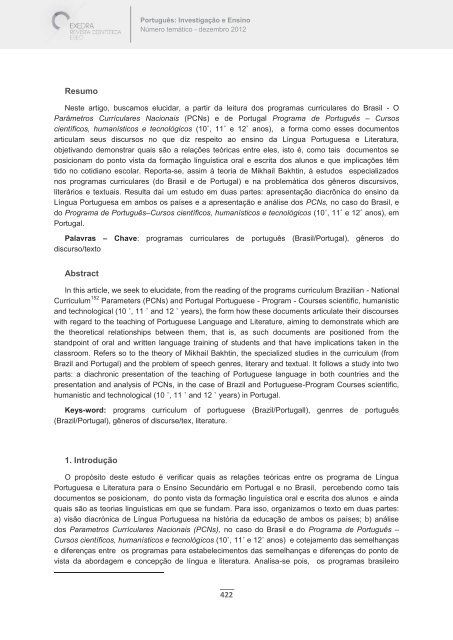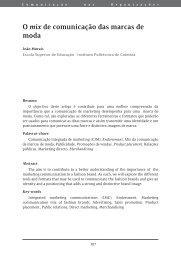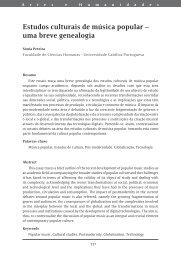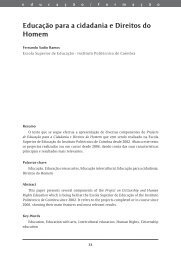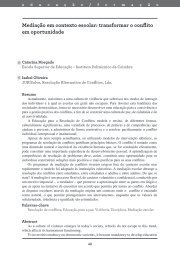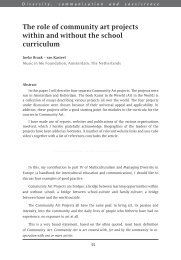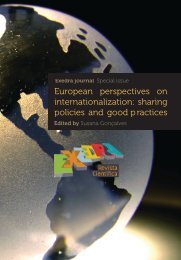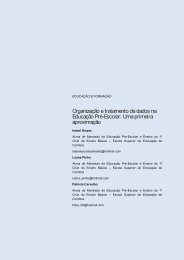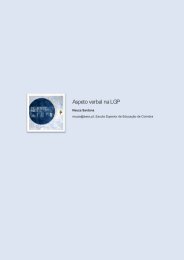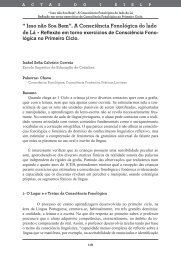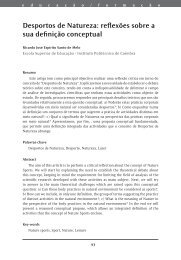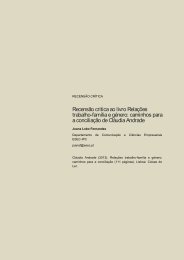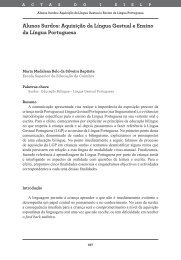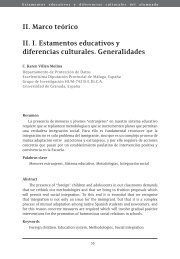Programas de Português do Ensino Secundário em ... - Exedra
Programas de Português do Ensino Secundário em ... - Exedra
Programas de Português do Ensino Secundário em ... - Exedra
Create successful ePaper yourself
Turn your PDF publications into a flip-book with our unique Google optimized e-Paper software.
<strong>Português</strong>: Investigação e <strong>Ensino</strong><br />
Número t<strong>em</strong>ático - <strong>de</strong>z<strong>em</strong>bro 2012<br />
Resumo<br />
Neste artigo, buscamos elucidar, a partir da leitura <strong>do</strong>s programas curriculares <strong>do</strong> Brasil - O<br />
Parâmetros Currículares Nacionais (PCNs) e <strong>de</strong> Portugal Programa <strong>de</strong> <strong>Português</strong> – Cursos<br />
científicos, humanísticos e tecnológicos (10˚, 11˚ e 12˚ anos), a forma como esses <strong>do</strong>cumentos<br />
articulam seus discursos no que diz respeito ao ensino da Língua Portuguesa e Literatura,<br />
objetivan<strong>do</strong> <strong>de</strong>monstrar quais são a relações teóricas entre eles, isto é, como tais <strong>do</strong>cumentos se<br />
posicionam <strong>do</strong> ponto vista da formação linguística oral e escrita <strong>do</strong>s alunos e que implicações têm<br />
ti<strong>do</strong> no cotidiano escolar. Reporta-se, assim à teoria <strong>de</strong> Mikhail Bakhtin, à estu<strong>do</strong>s especializa<strong>do</strong>s<br />
nos programas curriculares (<strong>do</strong> Brasil e <strong>de</strong> Portugal) e na probl<strong>em</strong>ática <strong>do</strong>s gêneros discursivos,<br />
literários e textuais. Resulta daí um estu<strong>do</strong> <strong>em</strong> duas partes: apresentação diacrônica <strong>do</strong> ensino da<br />
Língua Portuguesa <strong>em</strong> ambos os países e a apresentação e análise <strong>do</strong>s PCNs, no caso <strong>do</strong> Brasil, e<br />
<strong>do</strong> Programa <strong>de</strong> <strong>Português</strong>–Cursos científicos, humanísticos e tecnológicos (10˚, 11˚ e 12˚ anos), <strong>em</strong><br />
Portugal.<br />
Palavras – Chave: programas curriculares <strong>de</strong> português (Brasil/Portugal), gêneros <strong>do</strong><br />
discurso/texto<br />
Abstract<br />
In this article, we seek to elucidate, from the reading of the programs curriculum Brazilian - National<br />
Curriculum 152 Parameters (PCNs) and Portugal Portuguese - Program - Courses scientific, humanistic<br />
and technological (10 ˚, 11 ˚ and 12 ˚ years), the form how these <strong>do</strong>cuments articulate their discourses<br />
with regard to the teaching of Portuguese Language and Literature, aiming to <strong>de</strong>monstrate which are<br />
the theoretical relationships between th<strong>em</strong>, that is, as such <strong>do</strong>cuments are positioned from the<br />
standpoint of oral and written language training of stu<strong>de</strong>nts and that have implications taken in the<br />
classroom. Refers so to the theory of Mikhail Bakhtin, the specialized studies in the curriculum (from<br />
Brazil and Portugal) and the probl<strong>em</strong> of speech genres, literary and textual. It follows a study into two<br />
parts: a diachronic presentation of the teaching of Portuguese language in both countries and the<br />
presentation and analysis of PCNs, in the case of Brazil and Portuguese-Program Courses scientific,<br />
humanistic and technological (10 ˚, 11 ˚ and 12 ˚ years) in Portugal.<br />
Keys-word: programs curriculum of portuguese (Brazil/Portugall), genrres <strong>de</strong> português<br />
(Brazil/Portugal), gêneros of discurse/tex, literature.<br />
1. Introdução<br />
O propósito <strong>de</strong>ste estu<strong>do</strong> é verificar quais as relações teóricas entre os programa <strong>de</strong> Língua<br />
Portuguesa e Literatura para o <strong>Ensino</strong> <strong>Secundário</strong> <strong>em</strong> Portugal e no Brasil, perceben<strong>do</strong> como tais<br />
<strong>do</strong>cumentos se posicionam, <strong>do</strong> ponto vista da formação linguística oral e escrita <strong>do</strong>s alunos e ainda<br />
quais são as teorias linguísticas <strong>em</strong> que se fundam. Para isso, organizamos o texto <strong>em</strong> duas partes:<br />
a) visão diacrónica <strong>de</strong> Língua Portuguesa na história da educação <strong>de</strong> ambos os países; b) análise<br />
<strong>do</strong>s Parametros Currículares Nacionais (PCNs), no caso <strong>do</strong> Brasil e <strong>do</strong> Programa <strong>de</strong> <strong>Português</strong> –<br />
Cursos científicos, humanísticos e tecnológicos (10˚, 11˚ e 12˚ anos) e cotejamento das s<strong>em</strong>elhanças<br />
e diferenças entre os programas para estabelecimentos das s<strong>em</strong>elhanças e diferenças <strong>do</strong> ponto <strong>de</strong><br />
vista da abordag<strong>em</strong> e concepção <strong>de</strong> língua e literatura. Analisa-se pois, os programas brasileiro<br />
422


